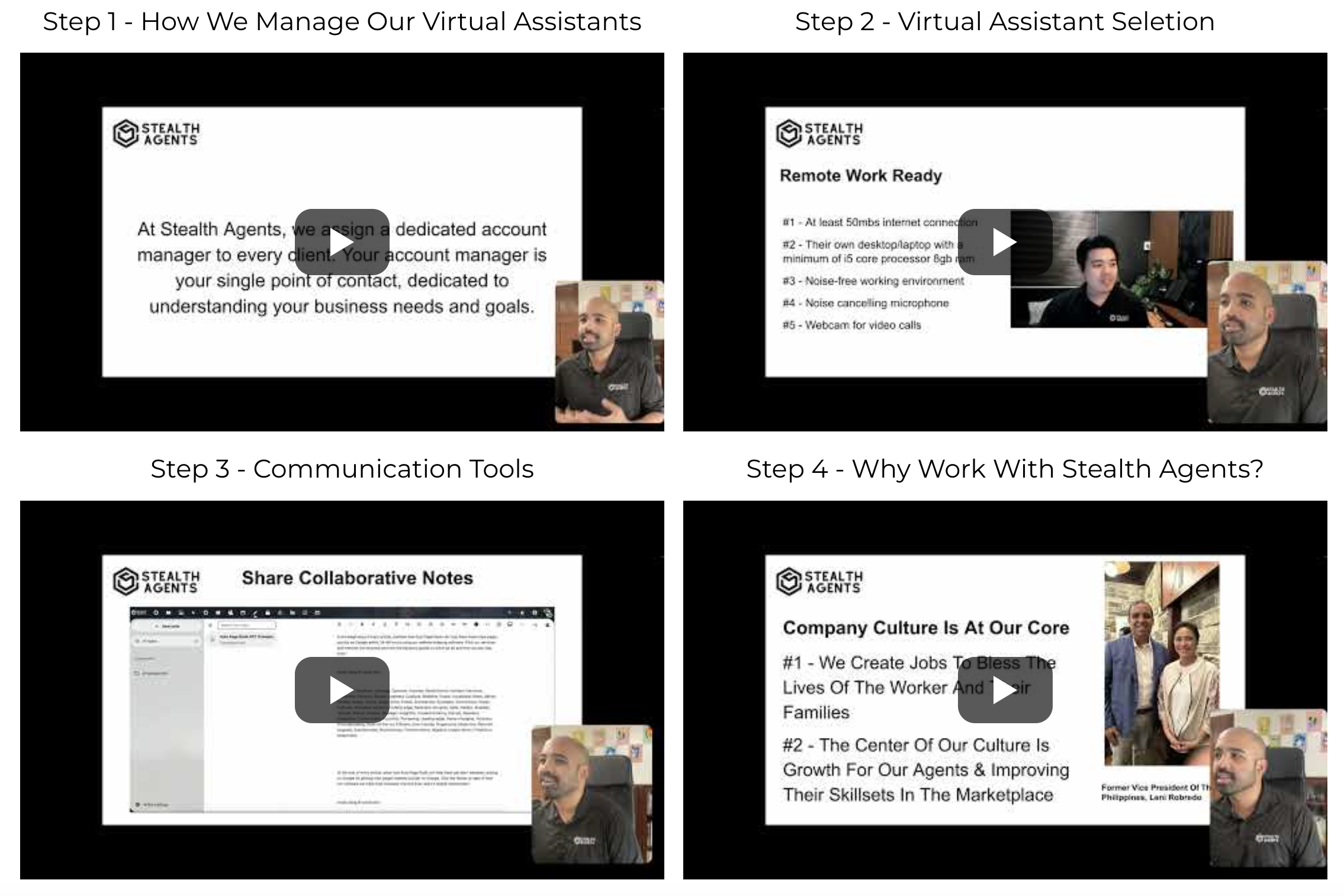Choosing the right communication tool can significantly impact team productivity and cohesion. Slack vs Redbooth are leading platforms designed to streamline team communication, yet they cater to different needs.
Slack is renowned for its robust messaging capabilities, seamless integration with countless third-party apps, and user-friendly interface that keeps team members connected in real-time.
However, Redbooth excels in project management; it provides an extensive set of tools, such as task lists, timetables, and file-sharing features, which makes it the perfect choice for teams working on complex project execution.
Redbooth offers an organized atmosphere for effectively managing tasks and deadlines, whereas Slack encourages direct and instantaneous collaboration.
Recognizing these variations can assist companies in identifying which platform aligns best with their operational goals.
Stealth Agents has meticulously compiled this resource, leveraging their expertise to guide you in making an informed decision and ensuring your team adopts a solution that increase productivity and collaboration.
What is Slack?
Slack is a powerful collaboration tool designed to enhance team communication and streamline workflow processes in a digital environment.
Primarily functioning as a messaging app, it enables teams to communicate in real time, share files, and integrate with numerous third-party services to boost productivity.
With channels for organizing conversations, Slack allows teams to focus discussions by topic, project, or department, making it easier to manage and retrieve information.
Its intuitive interface supports desktop and mobile use, ensuring that team members remain informed and engaged despite location.
By fostering efficient communication, Slack helps eliminate email clutter and combines all the necessary tools in one centralized platform.
Key Features:
- Real-Time Messaging: Slack facilitates instant communication with direct messages, group chats, and video calls, ensuring teams stay connected and responsive.
- Channel Organization: Users can create channels to segment discussions by top c, department, or project, which helps maintain organized and relevant conversations.
- App Integrations: Slack offers integrations with over 2,000 apps, allowing users to connect their favorite tools and automate tasks directly within the platform.
- File Sharing and Storage: The platform supports easy file sharing, enabling users to upload, share, and edit documents collaboratively, all stored in a centralized location.
- Search Functionality: With powerful search capabilities, users can quickly find past messages, files, and conversations, making information retrieval efficient and time-saving.
Pros:
- Enhanced Team Collaboration: Slack’s real-time communication features and organized channels promote efficient teamwork, making it easier allowing members of the team to communicate and exchange ideas quickly.
- Wide Range of Integrations: With extensive app integrations, Slack allows teams to streamline their workflows by connecting various tools, reducing the need to switch between multiple applications.
- User-Friendly Interface: Its intuitive and clean design makes Slack easy to navigate, minimizing the learning curve for new users and ensuring that even non-tech-savvy team members can quickly adapt.
- Accessibility Across Devices: Slack’s availability on mobile and desktop platforms ensures team members can access the tools and information they need, regardless of location or device.
- Customizable Notifications: Users may adjust their notification settings to customize the frequency and kind of notifications they receive to help them focus and reduce distractions.
Cons:
- Potential for Information Overload: Slack’s numerous channels and constant notifications can become overwhelming, leading to distractions if not appropriately managed.
- Dependence on Internet Connectivity: Slack requires a stable Internet connection as a cloud-based tool, which may hinder access and productivity in areas with poor connectivity.
- Limited Free Plan Features: The free version of Slack offers limited features, such as restricted access to message history and integrations, which might not suffice for larger teams.
- Cost for Premium Features: Unlocking Slack’s full potential requires a paid subscription, which can be a significant expense for small businesses or startups.
- Security Concerns: Although Slack employs security measures, some businesses may have concerns about data privacy and the safety of private data exchanged on the site.
What is Redbooth?
Redbooth is a versatile application for project management and collaboration created to assist teams in streamlining their operations and stay organized.
It offers a comprehensive suite of features that facilitate task management, time tracking, and team collaboration, making it a suitable choice for managing complex projects.
Redbooth allows users to create workspaces for different teams or projects where tasks can be assigned, tracked, and completed efficiently.
With its user-friendly interface, team members can easily navigate projects and keep up-to-date with ongoing tasks, ensuring deadlines are met.
Redbooth enhances productivity and helps teams achieve their goals more effectively by centralizing all project-related communications and documents.
Key Features:
- Task Management: Redbooth provides tools for creating, assigning, and tracking tasks, ensuring every team member knows their responsibilities and deadlines.
- Time Tracking: The platform includes built-in time-tracking capabilities, enabling groups to track the amount of time spent on each task and project.
- Workspaces: Users can set up dedicated workspaces for different projects or teams, keeping all related tasks, files, and discussions in one organized location.
- Gantt Charts: Redbooth offers Gantt charts to visualize project timelines, helping teams plan and adjust schedules to meet deadlines.
- File Sharing: The platform allows for easy sharing and storage of documents, ensuring all team members can access the latest files and information.
Pros:
- Enhanced Organization: Redbooth’s structured approach to project management helps teams organize their work efficiently, reducing confusion and increasing productivity.
- Comprehensive Project Insights: Features like time tracking and Gantt charts give users valuable insights into project progress and allow them to make data-driven decisions to improve efficiency.
- Collaboration-Focused: The tool facilitates seamless teamwork and communication to make sure everyone is on the same page and engaged with project objectives.
- Intuitive Interface: Redbooth’s interface is designed to be user-friendly, facilitating teams’ adoption and utilize the platform’s full range of features.
- Integration Capabilities: Redbooth integrates with various third-party applications, allowing teams to connect their existing tools further and streamline workflows.
Cons:
- Steeper Learning Curve: While comprehensive, the range of features may require new users to learn how to navigate and utilize the platform effectively.
- Potential Overkill for Small Teams: Redbooth’s extensive features might be unnecessary or overwhelming for smaller teams or less complex projects.
- Limited Free Plan Options: The free version of Redbooth offers limited functionality, which might only meet the needs of some users or larger projects.
- Pricing for Premium Features: Accessing advanced features requires a paid subscription, which could be a barrier for small businesses or those on a tight budget.
- Dependence on Internet Access: As with many cloud-based instruments, a reliable internet connection is required fully utilize Redbooth, which could impact productivity in areas with poor connectivity.
Slack vs Redbooth: Detailed Features Comparison
1. Communication Capabilities
Slack is renowned for its exceptional communication features, offering real-time messaging, group chats, and video calls that keep teams connected and responsive.
It provides a platform where discussions can happen instantly, seamlessly integrating emojis and reactions that engage interactions.
On the other hand, Redbooth focuses more on project-related communication, incorporating task comments and workspace discussions to keep project conversations organized.
While Slack is ideal for spontaneous interactions and team bonding, Redbooth ensures that communication is tightly linked to specific tasks and projects, offering a more structured approach.
Therefore, choosing between S ack and Redbooth for communication depends on whether your team prioritizes real-time interaction or project-focused discussions.
2. Task Management
Regarding task management, Redbooth is designed with project management at its core. It offers robust features like task assignments, deadlines, and progress tracking central to managing complex projects.
Redbooth also provides Gantt charts for visualizing schedules, making planning and adjusting timelines easier.
Conversely, Slack integrates with various project management tools to facilitate task management but does not inherently provide the same depth of features as Redbooth.
In the Slack vs Redbooth debate, if task management is a priority, Redbooth offers a more comprehensive suite tailored for this purpose.
3. Integration Ecosystem
Slack is a leader in app integrations, building connectivity with over 2,000 third-party applications.
Teams may now bring their preferred tools thanks to this into Slack, automating workflows and reducing the need to switch between applications.
Redbooth, while offering integration capabilities, focuses more on embedding project management tools within its platform, such as time tracking and file sharing.
The integration comparison between Slack vs Redbooth highlights Slack’s ability to serve as a central hub for various tools. In contrast, Redbooth provides built-in functionalities catering to project management needs.
4. User Interface and Experience
Slack’s interface is designed to be intuitive and visually appealing, making navigation straightforward and minimizing the learning curve for new users.
Its clean and modern design encourages customer engagement strategy and ensures teams can easily access the platform’s features.
Redbooth, while user-friendly, offers a more feature-rich experience that might require some initial learning to leverage its capabilities thoroughly.
In the Slack vs Redbooth comparison, Slack scores higher for ease of use and interface design, while Redbooth’s interface is tailored for users who require comprehensive project management tools.
5. Pricing and Accessibility
Slack has a free plan with limited functionality. However, a subscription is required to use Slack to its fullest, which may be pricey for bigger teams.
Like Slack, Redbooth also has a free version, but like Slack, its more complex features are only accessible with subscription plans.
Accessibility-wise, both platforms are cloud-based, requiring a stable internet connection, which might be essential in places where connectivity is scarce.
The Slack vs Redbooth assessment in pricing and accessibility suggests that while both tools require an investment for premium features, the decision might depend on the specific features and functionalities critical to your team’s needs.
How do Stealth Agents Choose Slack vs Redbooth?
When Stealth Agents choose between Slack vs Redbooth, they meticulously evaluate several critical factors to ensure the best fit for a business’s unique needs.
They consider the size of the team, recognizing that larger teams might benefit from Slack’s robust communication features to facilitate seamless interaction across departments.
Redbooth’s comprehensive task management capabilities become a deciding factor for projects with higher complexity, allowing teams to track progress efficiently through tools like Gantt charts.
Communication needs are also assessed. Slack is favored for teams that require real-time, dynamic interactions, while Redbooth suits those who prefer structured, project-focused discussions.
Integration requirements play a significant role, as Slack’s extensive app ecosystem can be crucial for businesses reliant on third-party tools.
In contrast, Redbooth’s built-in best project management software functionalities might suffice for others.
Stealth Agents leverage their expertise to guide businesses, ensuring that the chosen platform aligns with their strategic objectives and operational workflows.
Ultimately, their business decision-making strategies process is driven by a deep understanding of how these tools can enhance productivity and collaboration in diverse work environments.
If you are also looking for a virtual assistant ,Stealth Agents stands ready to assist . Book a free discussion to tailor preferences and explore virtual assistant pricing options.
Conclusion
The choice between Slack vs Redbooth hinges on the team’s specific needs and priorities.
Slack stands out for its unparalleled communication features, making it ideal for teams that thrive on real-time interaction and need extensive app integrations.
Redbooth, however, shines in its project management offerings, providing top task management tools and project planning that are essential for managing complex workflows.
Both platforms have their strengths, and the decision often depends on whether a team prioritizes communication fluidity or project management efficiency.
By understanding each tool’s distinct features and benefits, teams can decide with the knowledge that will best support their collaborative efforts and business goals.












